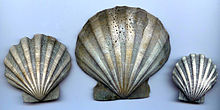Chesapecten
| Chesapecten Temporal range: Early Miocene to Early Pleistocene
| |
|---|---|

| |
| Chesapecten jeffersonius (outside) | |

| |
| Chesapecten jeffersonius (inside) | |
| Scientific classification | |
| Kingdom: | |
| Phylum: | |
| Class: | |
| Order: | |
| Family: | |
| Genus: | †Chesapecten
|
| Binomial name | |
| Chesapecten (Ward & Blackwater, 1975)
| |
Chesapecten is an extinct genus of scallop known from marine strata from the early Miocene to the early Pleistocene of the Eastern United States.[1]
Description
Like some other large scallops, the shells of Chesapecten are characterized by a pattern of wide ribs which radiate outward from the apex of the shell. A distinctive feature of Chesapecten is that the radial ribs on its shell are crossed by much smaller, rough, concentric ribs, which follow the contours of the edges of the shell (are "conmarginal"). The left valve of Chesapecten is more convex than the right valve. The adductor muscle scar is large and rounded.
Distribution
The geographical distribution of Chesapecten is limited to the Atlantic coastal plain of North America,[2] where it can be found as far south as Florida, and as far north as Delaware.[3] One species of Chesapecten, Chesapecten jeffersonius, is the state fossil of Virginia.[4]
History of the taxonomy
Chesapecten was the first genus of North American fossil to be described and illustrated; a drawing of C. jeffersonius appeared in English naturalist Martin Lister's Historiae Conchyliorum, Liber III in 1687. However, Lister did not give Chesapecten its name.[2] Chesapecten was formally named in 1975 by the paleontologists Ward and Blackwater. In 1980, it was assigned to the family Pectinidae by Harold E. Vokes.[1] The name Chesapecten comes from the Chesapeake Bay, where eroding cliffs and outcrops along the beaches regularly expose specimens.[2]
Habitat and behavior
Chesapecten lived on the seabed in coastal waters ranging in depth from a few feet to 130 feet. When not moving, it is assumed to have rested its flatter right valve on the seafloor. It is very likely that Chesapecten could move suddenly to escape a predator by flapping its valves and using the resulting jet propulsion, in a manner similar to that of almost all living scallops.[2]
Species
Species in the genus Chesapecten include:
- †C. crassus[5]
- †C. coccymelus[1]
- †C. jeffersonius[1]
- †C. madisonius[1]
- †C. marylandicus[6]
- †C. middlesexensis[5]
- †C. monicae[5]
- †C. nefrens[6]
- †C. patagonensis[1]
- †C. santamaria[1]
- †C. sayanus[1]
- †C. septenarius[5]
- †C. skiptonensis[1]
References
- ^ a b c d e f g h i "Information on Chesapecten from The Paleobiology Database". Retrieved 2010-09-29.
- ^ a b c d National Audubon Society Field Guide to North American Fossils, page 465-466, Alfred A. Knopf Publishing New York, ISBN 0-394-52412-8
- ^ Goewert, A. E.; Surge, D. (2007). "NASA ADS: Seasonal Variations Preserved in an Extinct Neogene Scallop, Chesapecten, from Florida to Delaware, USA and its Implications for Paleobiogeography". American Geophysical Union. 51. Bibcode:2007AGUFMPP51E..05G.
- ^ "The Geology of Virginia". Retrieved 2010-09-29.
- ^ a b c d "Chesapecten Nefrens - zipcodezoo.com". Retrieved 2010-09-29.
- ^ a b "Bulletin 20: Miocene Fossils of Maryland". Retrieved 2010-09-29.
Further reading
Online photo gallery with several pictures of Chesapecten nefrens
Information about Chesapecten from the Global Biodiversity Information Facility
Images of Chesapecten from Google Images
